Published
Sat, Jan 25, 2014, 04:30
- Here's what excited us on the second day of the annual gear showcase.
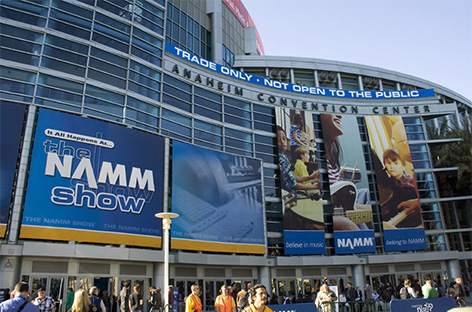
After a fruitful wander through the Anaheim Convention Center yesterday, we dove back into the NAMM Show this morning in search of more exciting new finds. No, Roland didn't display their new miracle throwback box, but that was the only true disappointment of the show. Even if we didn't see any true game-changers on the floor this year, we really liked what we saw.
Here are some of the highlights from Day 2.
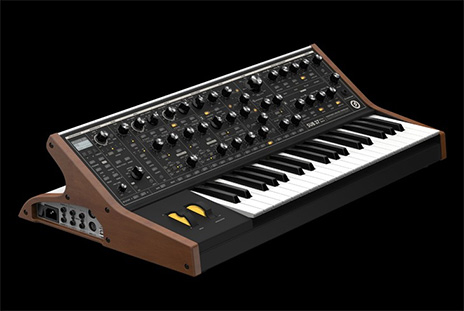 Moog Sub 37 Tribute
It's safe to say that Moog's booth, decked out in an abstract-minimalist paint job and overflowing with quirky potted plants, had the best vibe on the floor. Their new product this year would have stood out even without the charm offensive. First floated last week in a forum post, the Sub 37 Tribute is the new limited-edition flagship in the company's Phatty line. The synth is paraphonic (meaning you can play two notes at once), highly controllable (with 40 knobs and 74 switches to tweak) and classically Moog (not surprisingly, it features the company's legendary ladder filter). It's tough to get a feel for something this extensive when you've got dozens of impatient nerds breathing down your neck for their turn on the prototype, but it sounds great, looks like a million bucks and will cost you slightly less than that.
Moog will release the Sub 37 Tribute soon for a suggested retail price of $1,579.
Moog Sub 37 Tribute
It's safe to say that Moog's booth, decked out in an abstract-minimalist paint job and overflowing with quirky potted plants, had the best vibe on the floor. Their new product this year would have stood out even without the charm offensive. First floated last week in a forum post, the Sub 37 Tribute is the new limited-edition flagship in the company's Phatty line. The synth is paraphonic (meaning you can play two notes at once), highly controllable (with 40 knobs and 74 switches to tweak) and classically Moog (not surprisingly, it features the company's legendary ladder filter). It's tough to get a feel for something this extensive when you've got dozens of impatient nerds breathing down your neck for their turn on the prototype, but it sounds great, looks like a million bucks and will cost you slightly less than that.
Moog will release the Sub 37 Tribute soon for a suggested retail price of $1,579.
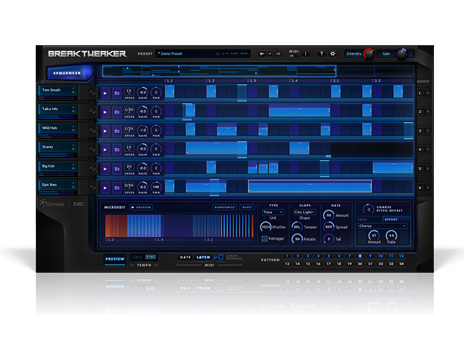 iZotope BreakTweaker
iZotope is best known for making relatively specialized audio engineering plug-ins like RX, a restoration tool. BreakTweaker is perhaps their most widely appealing offering yet, both for its feature set and price point. Yes, we're aware it's backed by the trance producer BT, but hear us out: BreakTweaker is a robust and creative beatmaking plug-in that has something to offer across styles. Though it comes with a horde of presets, it encourages you to create your own sounds, with support for samples and a sound engine based on wavetable synthesis. Like plenty of iZotope offerings before it, visual feedback is the lynchpin here—if you're working with synthesis, it gives you real time diagrams of how your knob-twiddling is affecting the wave shape, for example. BreakTweaker is entering a crowded marketplace with stiff competition from well established names like Native Instruments, but given time, this well designed toolkit should hold its own.
BreakTweaker is now available from iZotope for $199.
iZotope BreakTweaker
iZotope is best known for making relatively specialized audio engineering plug-ins like RX, a restoration tool. BreakTweaker is perhaps their most widely appealing offering yet, both for its feature set and price point. Yes, we're aware it's backed by the trance producer BT, but hear us out: BreakTweaker is a robust and creative beatmaking plug-in that has something to offer across styles. Though it comes with a horde of presets, it encourages you to create your own sounds, with support for samples and a sound engine based on wavetable synthesis. Like plenty of iZotope offerings before it, visual feedback is the lynchpin here—if you're working with synthesis, it gives you real time diagrams of how your knob-twiddling is affecting the wave shape, for example. BreakTweaker is entering a crowded marketplace with stiff competition from well established names like Native Instruments, but given time, this well designed toolkit should hold its own.
BreakTweaker is now available from iZotope for $199.
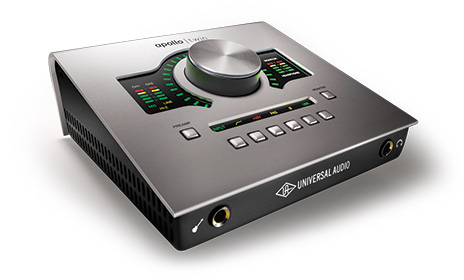 Universal Audio Apollo Twin
Speaking of crowded marketplaces, there's no shortage of small, tabletop audio interfaces. Universal Audio, whose Apollo racks have proven popular over the last few years, is entering the category to great fanfare regardless—it's the simplest, cheapest way to get access to their library of high-end plug-ins. The specs on the box are solid—24-bit/192-kHz conversion, Thunderbolt connectivity, two mic inputs and even an instrument input on the front. You're undoubtedly buying this for the chips, though, which let you run UAD's emulations of Neve channel strips, Lexicon reverbs, Studer tape machines and plenty else. (It's worth noting that most are sold separately.) It also features something called Unison technology, which lends its preamps the tone of classic tube and solid state ones via super-fast digital processing.
Universal Audio will release the Apollo Twin early this year for $699 with a UAD SOLO chip and $899 with a UAD DUO chip.
Universal Audio Apollo Twin
Speaking of crowded marketplaces, there's no shortage of small, tabletop audio interfaces. Universal Audio, whose Apollo racks have proven popular over the last few years, is entering the category to great fanfare regardless—it's the simplest, cheapest way to get access to their library of high-end plug-ins. The specs on the box are solid—24-bit/192-kHz conversion, Thunderbolt connectivity, two mic inputs and even an instrument input on the front. You're undoubtedly buying this for the chips, though, which let you run UAD's emulations of Neve channel strips, Lexicon reverbs, Studer tape machines and plenty else. (It's worth noting that most are sold separately.) It also features something called Unison technology, which lends its preamps the tone of classic tube and solid state ones via super-fast digital processing.
Universal Audio will release the Apollo Twin early this year for $699 with a UAD SOLO chip and $899 with a UAD DUO chip.
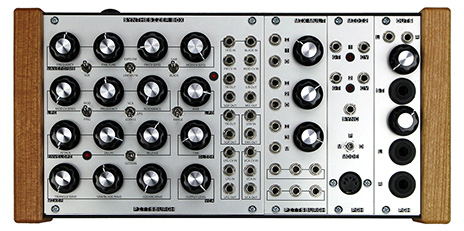 Pittsburgh Modular System 10
The Eurorack standard has helped make modular synthesis more accessible and customizable than ever. The systems are still ungainly, though, and it's not an easy task deciding where to begin. Pittsburgh Modular's System 10 is a solid place to start. The monosynth is actually semi-modular, meaning that it'll make sound whether or not you get busy with patch cables, and even if you stop there you'll still make some great sounds. It's fully patchable, though, so you're encouraged to get your hands dirty. The main Synthesizer Box features a complex waveforms oscillator and a low-pass gate (along with the heavy-hitters of subtractive synthesis), and you'll also find MIDI-to-CV, multifunction utility and output modules. Should System 10 whet your whistle for more modular gear, you can unscrew it from its casing and incorporate it into a more complete Eurorack setup. (If you're already more advanced, it's worth keeping an eye on their website, as they were showing off some other, far wilder new systems at their booth.)
Pittsburgh Modular will release System 10 soon for a suggested retail price of $649.
Pittsburgh Modular System 10
The Eurorack standard has helped make modular synthesis more accessible and customizable than ever. The systems are still ungainly, though, and it's not an easy task deciding where to begin. Pittsburgh Modular's System 10 is a solid place to start. The monosynth is actually semi-modular, meaning that it'll make sound whether or not you get busy with patch cables, and even if you stop there you'll still make some great sounds. It's fully patchable, though, so you're encouraged to get your hands dirty. The main Synthesizer Box features a complex waveforms oscillator and a low-pass gate (along with the heavy-hitters of subtractive synthesis), and you'll also find MIDI-to-CV, multifunction utility and output modules. Should System 10 whet your whistle for more modular gear, you can unscrew it from its casing and incorporate it into a more complete Eurorack setup. (If you're already more advanced, it's worth keeping an eye on their website, as they were showing off some other, far wilder new systems at their booth.)
Pittsburgh Modular will release System 10 soon for a suggested retail price of $649.
 Moog Sub 37 Tribute
It's safe to say that Moog's booth, decked out in an abstract-minimalist paint job and overflowing with quirky potted plants, had the best vibe on the floor. Their new product this year would have stood out even without the charm offensive. First floated last week in a forum post, the Sub 37 Tribute is the new limited-edition flagship in the company's Phatty line. The synth is paraphonic (meaning you can play two notes at once), highly controllable (with 40 knobs and 74 switches to tweak) and classically Moog (not surprisingly, it features the company's legendary ladder filter). It's tough to get a feel for something this extensive when you've got dozens of impatient nerds breathing down your neck for their turn on the prototype, but it sounds great, looks like a million bucks and will cost you slightly less than that.
Moog will release the Sub 37 Tribute soon for a suggested retail price of $1,579.
Moog Sub 37 Tribute
It's safe to say that Moog's booth, decked out in an abstract-minimalist paint job and overflowing with quirky potted plants, had the best vibe on the floor. Their new product this year would have stood out even without the charm offensive. First floated last week in a forum post, the Sub 37 Tribute is the new limited-edition flagship in the company's Phatty line. The synth is paraphonic (meaning you can play two notes at once), highly controllable (with 40 knobs and 74 switches to tweak) and classically Moog (not surprisingly, it features the company's legendary ladder filter). It's tough to get a feel for something this extensive when you've got dozens of impatient nerds breathing down your neck for their turn on the prototype, but it sounds great, looks like a million bucks and will cost you slightly less than that.
Moog will release the Sub 37 Tribute soon for a suggested retail price of $1,579.
 iZotope BreakTweaker
iZotope is best known for making relatively specialized audio engineering plug-ins like RX, a restoration tool. BreakTweaker is perhaps their most widely appealing offering yet, both for its feature set and price point. Yes, we're aware it's backed by the trance producer BT, but hear us out: BreakTweaker is a robust and creative beatmaking plug-in that has something to offer across styles. Though it comes with a horde of presets, it encourages you to create your own sounds, with support for samples and a sound engine based on wavetable synthesis. Like plenty of iZotope offerings before it, visual feedback is the lynchpin here—if you're working with synthesis, it gives you real time diagrams of how your knob-twiddling is affecting the wave shape, for example. BreakTweaker is entering a crowded marketplace with stiff competition from well established names like Native Instruments, but given time, this well designed toolkit should hold its own.
BreakTweaker is now available from iZotope for $199.
iZotope BreakTweaker
iZotope is best known for making relatively specialized audio engineering plug-ins like RX, a restoration tool. BreakTweaker is perhaps their most widely appealing offering yet, both for its feature set and price point. Yes, we're aware it's backed by the trance producer BT, but hear us out: BreakTweaker is a robust and creative beatmaking plug-in that has something to offer across styles. Though it comes with a horde of presets, it encourages you to create your own sounds, with support for samples and a sound engine based on wavetable synthesis. Like plenty of iZotope offerings before it, visual feedback is the lynchpin here—if you're working with synthesis, it gives you real time diagrams of how your knob-twiddling is affecting the wave shape, for example. BreakTweaker is entering a crowded marketplace with stiff competition from well established names like Native Instruments, but given time, this well designed toolkit should hold its own.
BreakTweaker is now available from iZotope for $199.
 Universal Audio Apollo Twin
Speaking of crowded marketplaces, there's no shortage of small, tabletop audio interfaces. Universal Audio, whose Apollo racks have proven popular over the last few years, is entering the category to great fanfare regardless—it's the simplest, cheapest way to get access to their library of high-end plug-ins. The specs on the box are solid—24-bit/192-kHz conversion, Thunderbolt connectivity, two mic inputs and even an instrument input on the front. You're undoubtedly buying this for the chips, though, which let you run UAD's emulations of Neve channel strips, Lexicon reverbs, Studer tape machines and plenty else. (It's worth noting that most are sold separately.) It also features something called Unison technology, which lends its preamps the tone of classic tube and solid state ones via super-fast digital processing.
Universal Audio will release the Apollo Twin early this year for $699 with a UAD SOLO chip and $899 with a UAD DUO chip.
Universal Audio Apollo Twin
Speaking of crowded marketplaces, there's no shortage of small, tabletop audio interfaces. Universal Audio, whose Apollo racks have proven popular over the last few years, is entering the category to great fanfare regardless—it's the simplest, cheapest way to get access to their library of high-end plug-ins. The specs on the box are solid—24-bit/192-kHz conversion, Thunderbolt connectivity, two mic inputs and even an instrument input on the front. You're undoubtedly buying this for the chips, though, which let you run UAD's emulations of Neve channel strips, Lexicon reverbs, Studer tape machines and plenty else. (It's worth noting that most are sold separately.) It also features something called Unison technology, which lends its preamps the tone of classic tube and solid state ones via super-fast digital processing.
Universal Audio will release the Apollo Twin early this year for $699 with a UAD SOLO chip and $899 with a UAD DUO chip.
 Pittsburgh Modular System 10
The Eurorack standard has helped make modular synthesis more accessible and customizable than ever. The systems are still ungainly, though, and it's not an easy task deciding where to begin. Pittsburgh Modular's System 10 is a solid place to start. The monosynth is actually semi-modular, meaning that it'll make sound whether or not you get busy with patch cables, and even if you stop there you'll still make some great sounds. It's fully patchable, though, so you're encouraged to get your hands dirty. The main Synthesizer Box features a complex waveforms oscillator and a low-pass gate (along with the heavy-hitters of subtractive synthesis), and you'll also find MIDI-to-CV, multifunction utility and output modules. Should System 10 whet your whistle for more modular gear, you can unscrew it from its casing and incorporate it into a more complete Eurorack setup. (If you're already more advanced, it's worth keeping an eye on their website, as they were showing off some other, far wilder new systems at their booth.)
Pittsburgh Modular will release System 10 soon for a suggested retail price of $649.
Pittsburgh Modular System 10
The Eurorack standard has helped make modular synthesis more accessible and customizable than ever. The systems are still ungainly, though, and it's not an easy task deciding where to begin. Pittsburgh Modular's System 10 is a solid place to start. The monosynth is actually semi-modular, meaning that it'll make sound whether or not you get busy with patch cables, and even if you stop there you'll still make some great sounds. It's fully patchable, though, so you're encouraged to get your hands dirty. The main Synthesizer Box features a complex waveforms oscillator and a low-pass gate (along with the heavy-hitters of subtractive synthesis), and you'll also find MIDI-to-CV, multifunction utility and output modules. Should System 10 whet your whistle for more modular gear, you can unscrew it from its casing and incorporate it into a more complete Eurorack setup. (If you're already more advanced, it's worth keeping an eye on their website, as they were showing off some other, far wilder new systems at their booth.)
Pittsburgh Modular will release System 10 soon for a suggested retail price of $649.